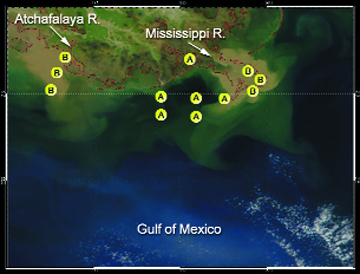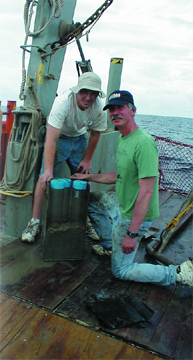
 The Mississippi
River drains almost half of the conterminous United States as it tracks an
ancient midcontinent rift valley on its way from northern Minnesota to the
Gulf of Mexico. This river system ranks sixth and seventh worldwide, in terms
of annual suspended sediment loads and water discharge, respectively. Combined,
the Mississippi River and its last major downstream distributary, the Atchafalaya
River, provide approximately 90 percent of the freshwater input to the Gulf
of Mexico. In addition to its sheer magnitude, the Mississippi River also
provides both an abundant source of water and an efficient mode of transportation
for diverse industries.
The Mississippi
River drains almost half of the conterminous United States as it tracks an
ancient midcontinent rift valley on its way from northern Minnesota to the
Gulf of Mexico. This river system ranks sixth and seventh worldwide, in terms
of annual suspended sediment loads and water discharge, respectively. Combined,
the Mississippi River and its last major downstream distributary, the Atchafalaya
River, provide approximately 90 percent of the freshwater input to the Gulf
of Mexico. In addition to its sheer magnitude, the Mississippi River also
provides both an abundant source of water and an efficient mode of transportation
for diverse industries.
This SeaWiFS image of the Mississippi River plume on March 22, 2001, shows
site locations of coring stations in the Mississippi Bight for studying sediment-associated
contaminants. “A” sites represent variable degrees of oxygen depletion
in the water column and variable influences from the river discharge; “B”
sites indicate where researchers are studying short-term deposits. Image courtesy
of Peter Swarzenski.
Because this river is also a direct source of drinking water to many downstream
municipalities, including New Orleans, an accurate assessment of the environmental
state of the Mississippi River and its discharge to the Gulf is both warranted
and essential. Thus, the U.S. Geological Survey (USGS), working with scientists
from various universities and state agencies, is investigating the historic
downstream delivery of sediment-associated contaminants into the Gulf of Mexico.
We propose that basic biogeochemical processes in the lower Atchafalaya River,
which empties into a broad, shallow receiving basin, are fundamentally different
from those in the lower Mississippi River, which discharges into the Gulf
of Mexico very close to the shelf break. Secondly, we think that river discharge,
as well as complex physical processes, affect the flux and fate of materials
moving off the continent into the Gulf of Mexico.
Dynamic role
Previous studies confirm that dissolved constituents carried in the lower
Mississippi River are generally not significantly elevated relative to other
large rivers globally, despite the implied industrial influences. However,
most river trace metals reside in a particulate (greater than 0.45 micrometers)
pool that often includes reactive colloidal-sized particles.
The fate of sediment-hosted contaminants is linked dynamically to particles
within a river. Biogeochemical reactions can remove a contaminant from the
dissolved pool, which leads to its deposition and accumulation in riverbed
sediments. During times of increased discharge, such as flooding and spring
melt events, resuspension of the contaminants from the sediments into the
river’s water column may occur. These processes of short-term storage
and resuspension of sediments are closely tied to the hydrologic cycle and
are significant in determining the subsequent flux of materials off the continent.
While the Mississippi River receives most of its water from the Ohio River
basin, most of the suspended sediments originate from the Missouri River watershed.
At the Old River control structure upstream of Tarbert Landing, Miss., two
human-made channels connect the main stem Mississippi with the Red and Atchafalaya
rivers. This regulated diversion of composite Mississippi River water into
the more recently formed Atchafalaya River (a branch since the 1500s) allows
for a direct comparison of the effect of changing basins and shelf conditions
on the off-continent material flux.
Alterations to the natural flow of the river can affect both suspended sediment
and dissolved loads. As the flow of the Mississippi is largely regulated,
the timing, location and energy of river water being discharged to the Gulf
plays a critical role in the development of offshore water column stratification
and the availability of select river-borne constituents to biological processes
(bioavailability).
Suspended sediment concentrations in the Mississippi River have declined dramatically
during the last half of the 20th century. For example, long-term suspended
sediment loads in the river have fluctuated from about 1,576,000 tons per
day in 1951 to about 350,000 tons per day in 2002. Researchers have also observed
declines in the concentrations and loadings of organic carbon. Large flood
events may both affect future downstream suspended sediment concentrations
and inject elevated river-borne constituents directly into offshore waters.
The concentration of some nutrients transported downstream has increased dramatically
during the last decades. For example, the current (1980-1999) average nitrate
flux has increased almost threefold from what it was from 1955 to 1970. The
heightened flux of bioavailable nitrogen to the Gulf is partially responsible
in the formation and intensity of a large hypoxic (low oxygen concentrations
in the water column, defined as less than 2 milligrams per liter) zone that
occurs regularly in portions of the Mississippi Bight during summer months.
The largest zone of hypoxia in the western Atlantic occurs in this region,
and has been attributed in part to recent increased fertilizer use upstream.
Integrated approach
 To address
linkages between the short-term flux of material off the continent and coastal
hypoxia, we are currently comparing marine sediments at sites where the overlying
water column has been chronically hypoxic to sites that are typically oxygen-rich.
We are also developing a suite of geochemical tracers and biomarkers to provide
information about historic hypoxic conditions, as preserved in the recent
sedimentary record. Presumably, we can distinguish modern hypoxia from pre-anthropogenic
hypoxia by evaluating historic off-continent material fluxes in age-dated
sediments, as well as in individual coral bands.
To address
linkages between the short-term flux of material off the continent and coastal
hypoxia, we are currently comparing marine sediments at sites where the overlying
water column has been chronically hypoxic to sites that are typically oxygen-rich.
We are also developing a suite of geochemical tracers and biomarkers to provide
information about historic hypoxic conditions, as preserved in the recent
sedimentary record. Presumably, we can distinguish modern hypoxia from pre-anthropogenic
hypoxia by evaluating historic off-continent material fluxes in age-dated
sediments, as well as in individual coral bands.
Bob Rosenbauer of the U.S. Geological Survey in Menlo Park, Calif., and Brian
Kindinger of ETI Professionals in St. Petersburg, Fla., sample a sediment
box core collected on the R/V Longhorn during a summer 2003 cruise off the
Mississippi River. Photo by Marci Marot, USGS.
At the Flower Garden Banks coral reefs, which are located in the direct pathway
of the eastward-flowing Mississippi River plume, a suite of trace elements
analyzed from coral growths already are revealing a continuous record of Mississippi
River discharge. We are seeing a possible linkage between past fluctuations
in Mississippi River discharge and offshore hypoxic events prior to the widespread
use of fertilizers upstream.
Analyses of sediment cores using organic and inorganic tracers as well as
benthic foraminifera appear to provide a reliable record of the historic variability
of hypoxia in the northern Gulf of Mexico over the past few centuries. Natural
variability in hypoxic events may be driven largely by flooding cycles of
El Niño/La Niña prior to recent increases in nutrient loading.
Specifically, large floods in 1979, 1983, 1993 and 1998, compounded with the
widespread use of fertilizers, also appear at least partially responsible
for the recent (post-1980) dramatic increase of hypoxic events in the Mississippi
Bight.
Planned research will continue to explore and strengthen relationships between
off-continent material flux, the river’s delivery of contaminants in
sediment, and the occurrence and scale of hypoxic events. These studies will
take an integrated scientific approach that incorporates the fields of geochemistry,
geology, hydrology and biology.
 |
Geotimes Home | AGI Home | Information Services | Geoscience Education | Public Policy | Programs | Publications | Careers |